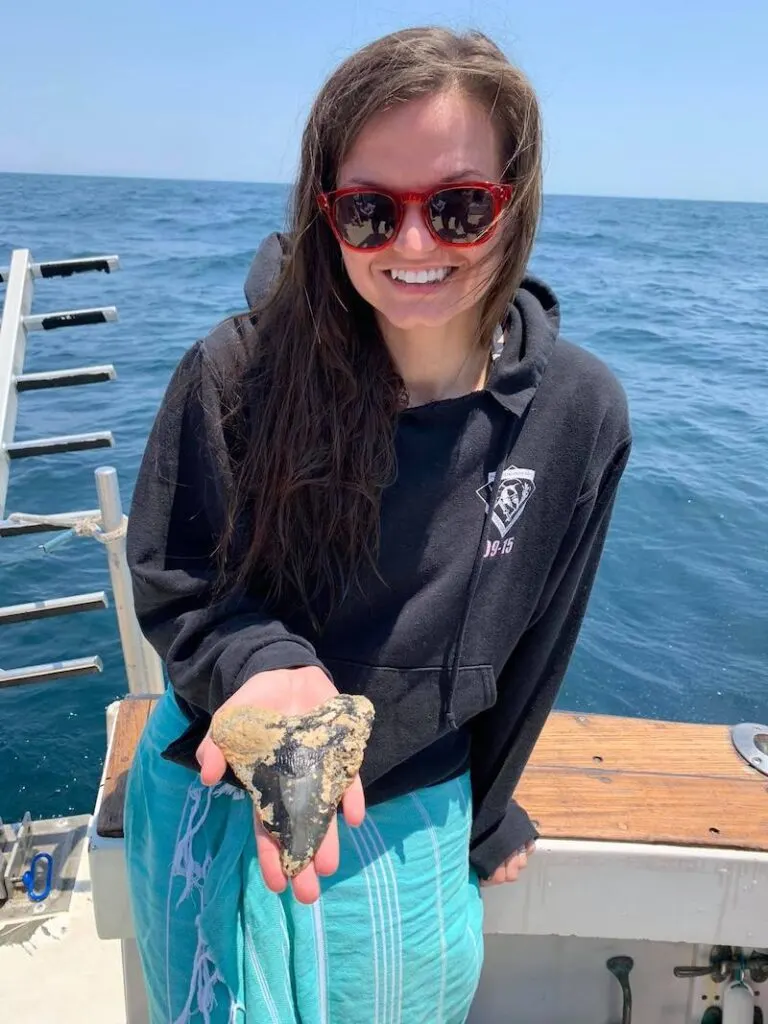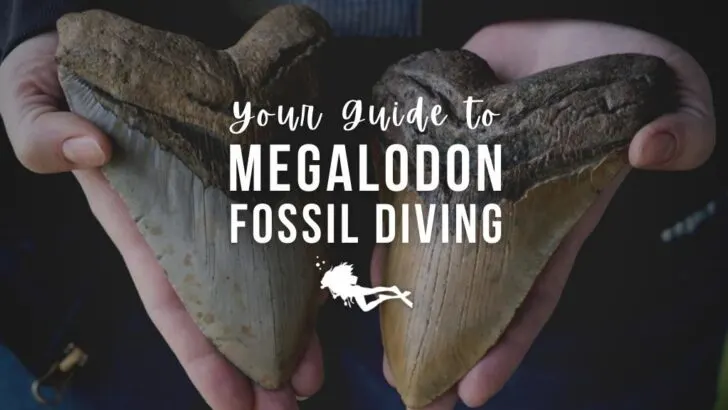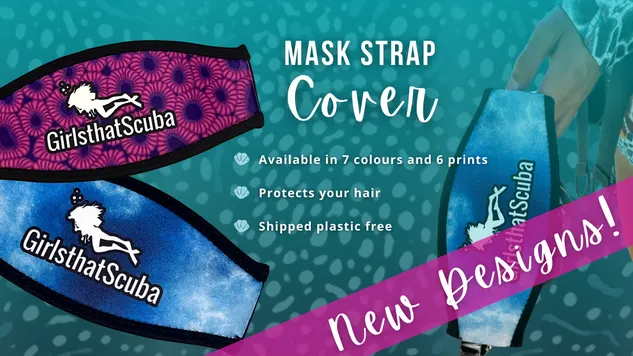Have you ever fancied bringing back a piece of incredible natural history from a dive? Hunting for millennia-old natural treasures may be closer than you think, with no Indiana Jones adventures necessary. From Florida up to North Carolina, the east coast of the United States is a hub for fossil diving. This is the place to be if you’re looking to uncover a tooth from the mighty megalodon.
We’ll be answering all your questions about scuba diving for fossils, so read on to learn about megalodon tooth diving in Florida and beyond. We’ll also cover whether it’s ethical to take fossils when diving, and what permits are needed for shark fossil diving.
What is megalodon tooth diving?
The megalodon is thought to be the largest shark ever to have lived. Scuba divers flock to offshore fossil hotspots to hunt for their gigantic gnashers. It’s thought that megalodon could be related to modern great white sharks due to the appearance of their teeth.

These fossilised teeth can be sold for a pretty penny. However, many divers simply enjoy the thrill of the hunt and the joy of collecting a magnificent dive memento. Whatever the reason for collecting them, it’s certainly impressive to be able to hold a piece of history which is millions of years old.
As well as megalodon teeth, fossil diving can also unearth other treasures. This can include fossilised shark teeth from other species such as mako sharks. Divers also find dugong ribs, mammoth teeth and whale jaw bones.
Where can I dive for megalodon teeth?
Whilst megalodon teeth have been found on every continent except Antarctica, they are particularly common on the East coast of the United States. Some of the most popular sites to find them include:
- Venice Beach, Florida
- Cooper River, Charleston, South Carolina
- “Meg Ledge”, Wilmington, North Carolina
- “Shark’s Tooth Island”, Savannah, Georgia
How much does shark tooth diving cost?
The cost of shark tooth diving can vary depending on state and dive operator. We have found prices varying from $90 for a two tank trip, to $110 for a three tank trip, and up to $250 for a two tank trip. Be sure to check what your trip includes, and avoid choosing an operator based on them offering the cheapest price.
Some cheaper prices may not include equipment rental. Remember to discuss this with the operator if you don’t have your own gear. You should also factor in tipping expectations from the dive operator.
Is it ethical to take megalodon teeth?
As divers we’ve always been taught to “take only pictures, leave only bubbles”. With that in mind, it can feel wrong to remove fossils from the underwater environment. However, local divers in these areas maintain that these practices don’t cause any lasting damage to the underwater environment.
Megalodon teeth are often found in areas with loose, sedimentary bottoms. This means that searching for the fossilised teeth doesn’t involve digging or damaging any delicate reef systems. A number of the popular fossil diving locations also have protected wrecks and sites nearby. This prevents divers from causing damage by searching in the wrong areas. The permits required for collecting these fossils (see below) also prohibit divers from disrupting the underwater environment to remove them.
Megalodon teeth are plentiful and fairly common, meaning that there is little demand to study them. This makes it more acceptable for divers to take them for their own private fossil collections. However, they are still a finite resource. As with any diving experience you should look for operators who take small groups and encourage responsible practices.
Do you need a permit to dive for shark tooth fossils?
Depending on where you’ll be diving for shark tooth fossils, you may need a permit to take them. If you’re fossil hunting in North Carolina or Georgia, permits are not required.
Florida
In Florida, the Florida Museum authorises fossil permits. Fossilised shark teeth are specifically excluded from the permit, so if you plan to only take shark teeth then a permit is not necessary. However it’s common to come across other natural treasures, so if you intend to take up any other fossils you should obtain a permit. At $5 for one year it’s a worthwhile expense in case you come across something impressive! Be sure to complete the application ahead of your trip to account for the three week processing time.
South Carolina
Under the South Carolina Underwater Antiquities Act, divers require a Hobby License to collect fossils. These can be obtained within 2-4 weeks, and will set you back $5-36 depending on duration and your resident status.
Both Florida and South Carolina’s permits require you to report your findings when you bring fossils back from a dive. Whilst this may seem tedious, it’s a worthwhile price to pay to be able to own a piece of history. The Florida Museum has also put together a valuable resource advising amateur fossil hunters on how to take care of their treasures.
What certification do I need for shark tooth diving?
Depending on where you plan to scuba dive for fossils, you may need to gain some extra experience first. Some popular megalodon tooth dive sites can be deep (30-40m, 98-131ft) with silty bottom compositions. The depth means that you will need to pay close attention to your no decompression limits. You may want to consider doing your nitrox certification to extend your bottom time.
Diving in areas with silt and sand means that you also need to have great buoyancy and propulsion (finning) techniques. This prevents you from disturbing the bottom and lowering the visibility. You should be confident diving in low visibility in case the silt is disturbed. This could be due to other divers or the conditions.
River sites such as Cooper River in South Carolina can also be subject to strong currents. Of the suggested locations in this article, Venice Beach in Florida has some of the shallowest and “easiest” sites to find megalodon teeth. This may be more suited to newer divers.
With these points in mind, some dive charters for shark fossil diving require you to be Advanced Open Water certified (from any certification agency) or above. If there is no minimum certification level required, they may have a minimum number of logged dives required instead.
Remember that these limitations are there in order to ensure you have a safe dive. Consider completing some more training and practice dives ahead of a fossil trip if you’re newly certified.
Have you been scuba diving for megalodon teeth? Share your underwater fossil finds with us in our Girls that Scuba Facebook group, or share to your Instagram stories and tag us – we’re @girlsthatscuba!




